
Two Pairs of Toshi Yoshida "Lifetime Edition" and "Posthumous Edition" Prints
'Block-Signed' Editions"

|
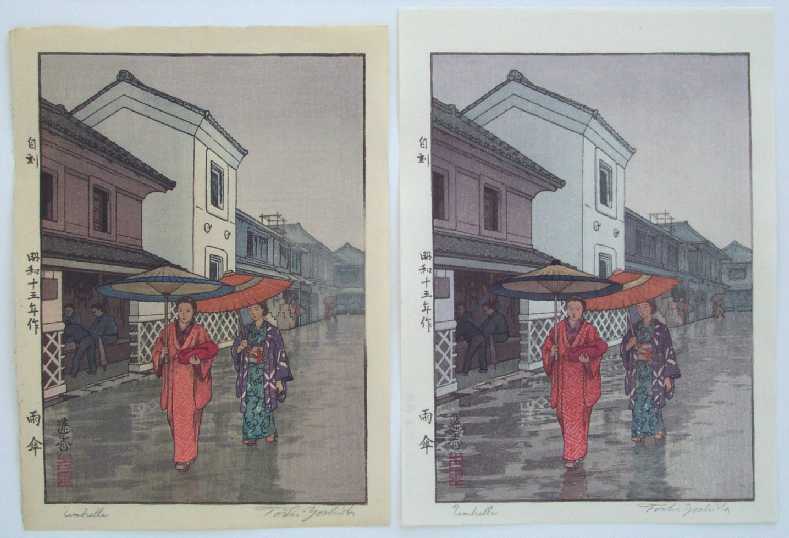
Toshi Yoshida's 1940 "pencil-signed" "Umbrella" (left), "block-signed" "Umbrella" (right) Toshi Yoshida's 1940 print "Umbrella" Seen just above is our first set of "same-as" prints--a pair of Toshi Yoshida's 1940 print titled "Umbrella." On the right is a slightly age-toned "life-time/pencil-signed" printing, and on the right is a somewhat fresher looking "posthumous/block-signed" printing. Here, the term "block-signed" refers to the fact that--although the print's "signature" LOOKS a lot like the hand-written signature of artist Toshi Yoshida--it is, in fact, "block-printed" from a hand-carved wooden copy of Toshi's written signature. (It is for this reason--their striking similarity of appearance--that beginning collectors of Japanese woodblock prints need to exercise some judgement when being presented a print offered as "pencil-signed" to determine if the print they're considering purchasing is, in fact, truly a "life-time/pencil-signed" printing. We'll have a bit more to say about this matter a bit later in this article.) 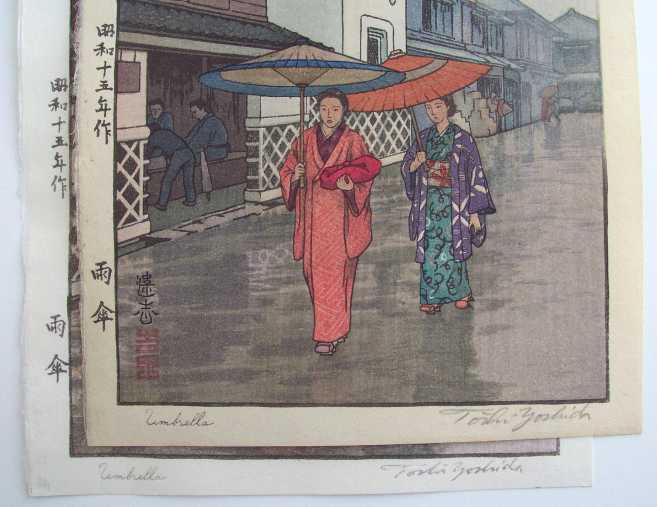
A Closer Look at both "Umbrella's" Japanese date and Japanese titles (older print on top) Next, looking above a bit closer at both of our "Umbrella" prints overlaid with their margins almost side-by-side (this time with the OLDER "pencil-signed" version placed on TOP), we can now clearly see the IDENTICAL nature of both print's Japanese dates (reads top to bottom: "Showa ju-go nen saku," or "Showa fifteen year made", or "1940") and Japanese titles (reads: "Amagasa," or "umbrella"). This identical appearance is fully as expected, as in both cases these markings are carved directly into this print's "key-block," ensuring that these markings will remain identical regardless of print's actual year of production. Again (as cautioned above), we are noting also with the nearly identical appearance of Toshi's true "pencil-signed" print on the top (offset slightly to the right), and his later posthumous "block-signed" (woodblock printed) signature on the bottom (offset slightly to the left) print. A Closer Comparison of Printing Quality Finally, at this point, let's zoom-in for a closer side-by-side comparison of these two print's quality with respect to the apparent care and skill demonstrated in their actual printing. This time, the older (age-toned) print is set to the left, with the fresher newer print seen to the right. 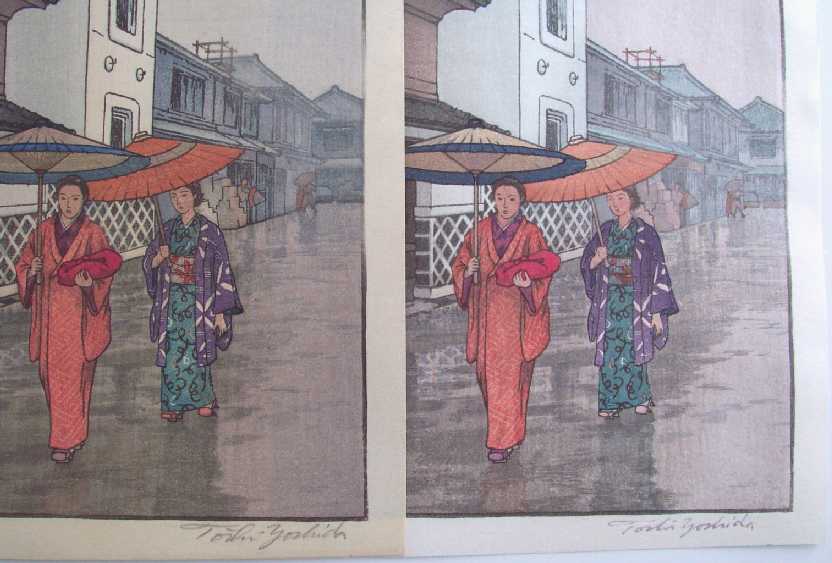
Comparing Printing Quality -- Older "Umbrella" Print (left), Newer "Umbrella" Print (right) At least to our experienced eyes, the printing quality of both prints seems to be nearly identical--with a skillful application of colors (to the numerous woodblocks involved) apparent in both prints. The matching of colors seen in the post-1995 print (right) is nearly identical to the colors which appear likely some 30 or 40 or 50 years earlier in the lifetime print--not easily accomplished, and certainly requiring a great deal of effort on the part of Yoshida Family Studio's later artisans. Both print's "bokashi" shading (gradation of colors) is similarly well done. Admittedly , one could argue that the older print's "distant buildings" are somewhat more carefully depicted. At the same time however, one could equally well argue that the newer print's "umbrella top" is more carefully (more convincingly) shaded and that the newer print's "reflection" seen in the wet pavement also appears more life-like. In any case--BOTH prints are certainly very skillfully printed and exhibit the quality for which the Yoshida Family Studio is so well known. Aesthetically speaking, the viewer is left feeling pleased with each print's presentation. |
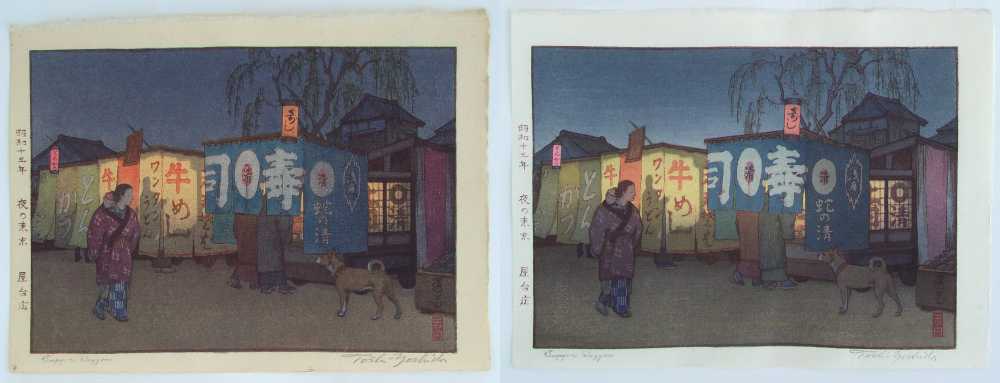
|
Toshi Yoshida's 1938 print "Supper Wagon" Seen just above is our second set of "same-as" prints--a pair of Toshi Yoshida's delightfully illuminated evening 1938 print titled "Supper Wagon." On the left is a slightly age-toned "life-time/pencil-signed" printing, and on the right we see a somewhat fresher looking "posthumous/block-signed" printing. As with our earlier example of Toshi's "Umbrella" print, again both the "pencil-signed" and "block-signed" signatures can seem nearly identical. In fact, so similar in appearance are these "lifetime" and "posthumously" prints, that collectors must exercise some caution to determine if a given print they're considering purchasing is, in fact, truly a "life-time/pencil-signed" printing. 
A Closer Look at both "Supper Wagon's" Japanese date and Japanese titles (older print on top) Next, looking above a bit closer at both of our "Supper Wagon" prints overlaid with their margins almost side-by-side (this time with the OLDER "pencil-signed" version placed on TOP), we can again clearly see the IDENTICAL nature of both print's Japanese dates (reads top to bottom: "Showa ju-san nen saku," or "Showa thirteen year made", or "1938") and Japanese titles (reads: "Yoru no Tokyo--Yataimise" or "Night in Tokyo--Supper Wagon"). As with our previous example, the identical nature of these markings is again as expected, as these Japanese characters are carved directly into this print's "key-block," ensuring that these markings will remain identical regardless of print's actual year of production. A Closer Comparison of Printing Quality As with our previous example, let's again zoom-in for a closer side-by-side comparison of these two print's quality with respect to the apparent care and skill demonstrated in their actual printing. As before, the older (age-toned) print is set to the left, with the fresher newer print seen to the right. 
Comparing Printing Quality -- Older "Supper Wagon" Print left, Newer Print right Again, at least to our reasonably experienced eyes, the printing quality as demonstrated in these two prints seems nearly identical--with a skillful application of colors (to a number of woodblocks) is clearly present in both prints. In this case, the matching of colors seen in the post-1995 print (right) are again largely identical to the colors which are seen in the 40 or 50 years earlier print, with one obvious exception being the differences seen in the purplish curtain to the far right of each print. Despite this observable difference, for the most part, the newer print's colors are well matched to the early edition's colors. Both print's "bokashi" shading (gradation of colors) is similarly well done. In the relatively small area examined above, one could certainly make the observation that the "illuminated shading" to the yellowish shoji screen is somewhat more skillfully depicted in the older print to the left. However, returning to the "full image" views of both prints (as seen higher above), one could equally well argue that the newer print's "evening sky" is more carefully (more convincingly) shaded than is that of the older lifetime print. As with our previous example of the "Umbrella" prints, both of our "Supper Wagon" prints are certainly very skillfully printed, and in each case leaves the viewer pleased with each print's presentation. One final observation can be made regarding some slight differences seen between our two above prints--namely a somewhat "smoother" textural color appearance to the larger/wider areas (such as sky or purple curtain areas) of the later printing seen on the right. It seems apparent that, over time, the repeated applications of pigments to a block's surface will slowly fill up the woodblock's pores, resulting in a gradual loss of "visible woodgrain" and therefore less "textural" appearance. Some Final Words of Advice about "Look-Alike" Signatures As we have suggested earlier, beginning and experienced collectors alike need to be somewhat careful when purchasing an assumed "lifetime" or "pencil-signed" print by either Toshi Yoshida or father Hisoshi Yoshida to be certain that they are getting what they are actually paying for. So remarkably similar in appearance are the true "pencil-signed" and carved/stamped "block-signed" signatures of artists Toshi Yoshida and Hiroshi Yoshida that one can be easily or unknowingly fooled into believing that a posthumously printed copy is, in fact, NOT a "lifetime/pencil-signed" printing as expected. To anyone who doubts the similarity and at times difficulty in differentiating pencil-signed" and carved/stamped "block-signed" signatures, we again return to our "Umbrella" and "Supper Wagon" prints seen just below. 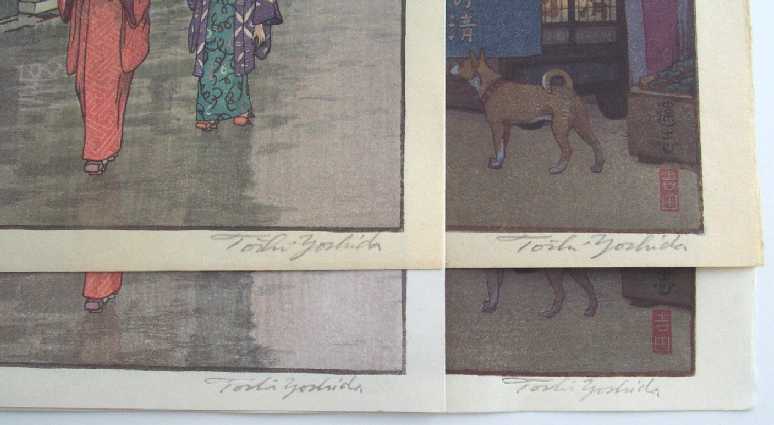
"Pencil-signed" signatures on top, "block-signed" signatures below Of course, the simple knowledge that "pencil-signed" and "block-signed" look so much alike is really all that a collector needs to remember--enough so that his or her suspicions will then result in a closer examination of any given print under consideration for purchase. That said, repeated from our earlier January 15, 2004 examination of two Toshi Yoshida "Mt. Fuji from Ohito, Morning" prints, we again offer these tips on how to avoid being fooled: First, holding the print's "signature" up against an angled light source, look carefully for the "shiny" appearance of a graphite pencil's lead. If the signature is observed to be "shiny," most certainly then it IS indeed a "pencil-signed" copy. A second thing to also check for in the same manner (again while holding print in an angled light source) is the presence of "embossing" or "pressing" into the paper's surface. Here, simply look for "edges and shadows"--if found, these are a strong indication that the "signature" is, in fact, "impressed" or "block-stamped" INTO the paper's surface by an inked, carved wooden signature block. If the collector takes the time to check a given print for both of these indicators, there is very little chance that he/she will be fooled. However, even with sharp eyesight, it can at times be difficult to immediately be sure. Here, a magnifying glass will prove to be a good friend. Those readers interested in reviewing one additional "paired example" of Toshi Yoshida's prints can do so by reviewing our short related article, "Toshi Yoshida Prints -- 'Pencil-Signed' vs "Block-Signed'".) Conclusion and Afterthought To collectors of Japanese woodblock prints, the seemingly difficult choice must at times be made as to whether one should purchase a typically more expensive "lifetime edition" printing, or instead, to purchase a less expensive "posthumous edition" printing that might equally well satisfy one's collecting desires and aesthetics. Certainly there is no definitive answer--and here, each collector will have to make his or her own decision. Hardcore collectors in most cases will likely continue to insist on adding only "lifetime" prints to their collections whenever possible. At the same time however, the vast majority of both new and experienced collectors will find that their print collecting interests can often be well met by choosing "posthumous" prints to add to their collections. Certainly in the case of prints by Toshi Yoshida, it has been well demonstrated by the above two examples that later, less expensive, "posthumous" prints can oftentimes be a good choice. The continued care and exceptional printing standards which have been maintained by the Yoshida Family Studio will ensure that these "later edition" prints will bring years of future enjoyment to new generations of print collectors.
|